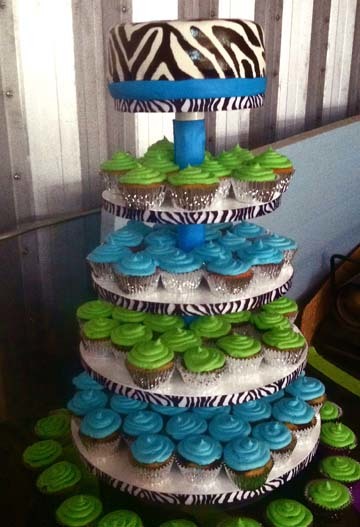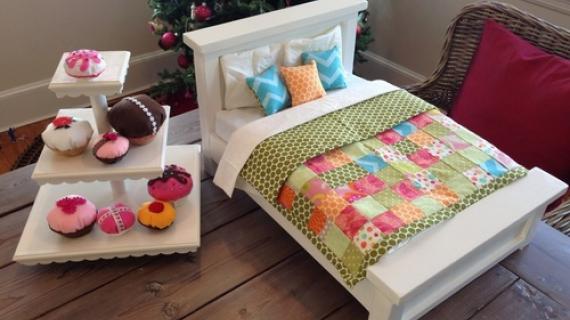
These things have become super popular lately, and I wanted to figure one out for later this summer but had the chance to use one for graduation so a few scraps and $5 in supplies later here it is...Super sturdy, holds close to 100 cupcakes and can be dressed up in any way you see fit.
If you have any questions I'll try and answer to the best of my ability. It really sounds more complicated than it is. It just takes a second to work through the logistics when assembling it. Don't rush and think through every step and questions should answer themselves.
Preparation
Scrap 1/2" plywood. I used a piece that was about 4ft by 18" and another small piece because one of my cirlcles overlapped. If you need new a 2 x 4 ft piece should be more than enough. You'll also need 1" PVC pipe, about 2 feet. For 5 tiers I used 6 1" couplers and 2 1" caps from the plumbing section also. You'll add 2 couplers for each additional tier.
Cut successive circles starting at either 6" or 8" in 2 inch increments until you have the desired number of tiers for your stand. Mine are 8" 10" 12" 14" and 16"
Cut successive circles starting at either 6" or 8" in 2 inch increments until you have the desired number of tiers for your stand. Mine are 8" 10" 12" 14" and 16" For the pipe you'll need 2 pieces just under 2" to connect 2 couplers together between each layer of plywood and 3 pieces just under 2 1/2" to connect layers between the couplers. The top and bottom are attached with 3" pieces of PVC.
Please read through the entire plan and all comments before beginning this project. It is also advisable to review the Getting Started Section. Take all necessary precautions to build safely and smartly. Work on a clean level surface, free of imperfections or debris. Always use straight boards. Check for square after each step. Always predrill holes before attaching with screws. Use glue with finish nails for a stronger hold. Wipe excess glue off bare wood for stained projects, as dried glue will not take stain. Be safe, have fun, and ask for help if you need it. Good luck!
Instructions
Step 1
Cut out all pieces of 1/2" plywood, and fill and sand as needed. The edges don't have to be perfect because they can be hidden with ribbon. Drill a 1 3/8" hole in the center of the middle 3 circles. I couldn't find a bit within my price range so I used a 1 1/4" bit and got creative to make it just a hair bigger.
Step 2
Assemble the top and bottom layers by gluing the pipe caps in the center (I used liquid nails) and using short screws to help hold it so it doesn't topple when full of cake. Make sure the top smallest circle has the cap attached on the bottom side.
Step 3
Once the top and bottom have had a chance to dry assemble the tower....bottom (biggest) circle, insert a 3 " piece of pipe into the cap, coupler, 2 1/2" pipe, stick a circle around the pipe, add another coupler, 2" pipe, coupler, 2 1/2" pipe, circle and so forth until you get to the last coupler, then add another 3" pipe and the top circle. The cap of the top layer should be attached to the bottom side of your circle.
Step 4
I chose to glue some of my pipe pieces together for ease of assembly and dis-assembly but it would probably hold it without being glued. The hubs in this house was afraid pressure would pop the layers apart but I really don't think it would. If you choose to glue make sure you take a second to plan and leave unglued pipes to be able to pop the pieces apart for ease of storing and transporting. Use pipe cleaner and glue not wood glue also! One little trick I used to make it easier to get layers apart is a touch of vaseline inside the couplers that you want to pop apart. Just make sure not to use vaseline on the ones you want to glue or you'll have a mess!
It is always recommended to apply a test coat on a hidden area or scrap piece to ensure color evenness and adhesion. Use primer or wood conditioner as needed.









Comments
melaniesue
Thu, 06/02/2011 - 13:42
These things are popular!
I have been trying to figure out how to do it, I think metal pipe would be so cute too, I just might have to tinker in the shop today! Cute, and thanks!
glennj
Thu, 06/02/2011 - 15:34
Thank you
A friend of mine asked for something like this for her wedding and I had originally said no being afraid to mess it up but with your directions perhaps I'll take some time and see if I can help her out.
Summer Brown (not verified)
Tue, 06/14/2011 - 22:34
How do you measure out the
How do you measure out the circles. What tool do you use?
Summer Brown (not verified)
Tue, 06/14/2011 - 22:42
Nevermind! We found bowls and
Nevermind! We found bowls and such to measure off of! I guess it would still be nice to know how you did it for future or for others though! Thanks!
Marci (not verified)
Thu, 06/30/2011 - 08:15
Measuring circles
I did exactly the same thing as you did. I wandered around my house finding everything round until I was satisfied with the sizes. I tried the string nail and pencil thing but my circles were never "round" enough. I also couldn't find a compass big enough to do the big ones...although if you're brave enough and don't care about the thickness of the line crayola used to carry a sidewalk chalk set that came with a huge compass that would probably work.
claydowling
Thu, 06/30/2011 - 10:52
The right tool for the job
There's a common machinists marking and layout tool called a divider. They don't usually sell them at Lowes or Home Depot, but I picked up a pair of them at Harbor Freight. One of them can be opened to just over a foot, which was perfect for the shelves I was building.
You could use them to scratch a mark directly (my recommendation), but the bigger set also has a collar to hold a pencil, turning it into a very large compass.
The pencil and string thing totally doesn't work for woodworking. It's fine for larger construction, like laying out a circular patio or fire pit.
Tsu Dho Nimh
Sat, 07/30/2011 - 11:09
Side View Please
Can you add a side view of the stand with no cakes on it?
It would be easier to understand how you put it all together.
mdesign
Mon, 08/08/2011 - 12:21
The post shows a photo of the
The post shows a photo of the side view but for whatever reason it wont show up! I've tried deleting it and re-uploading but nothing! Sorry!